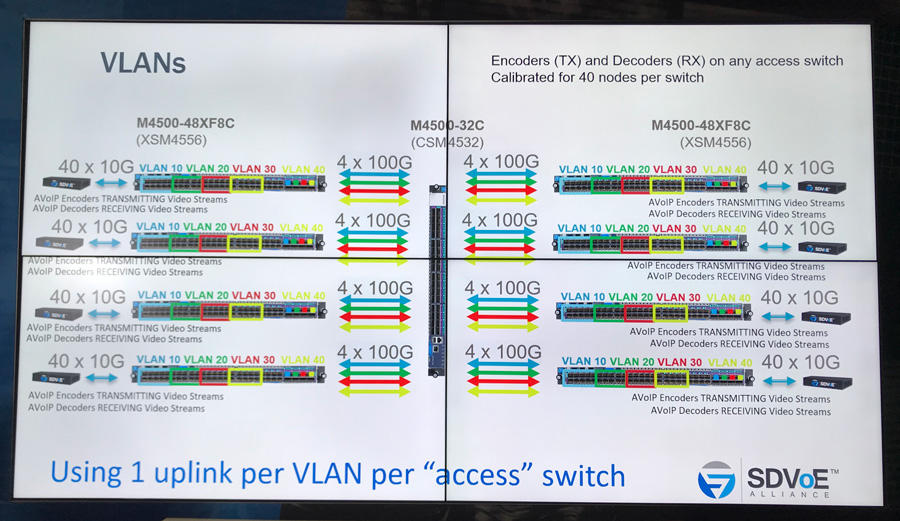In this latest edition of the ISE show hosted in Amsterdam, Netgear, a well-known brand of Wi-Fi access points or other powerline adapters, was on the show floor represented by its professional division.
The Netgear team shared a stand with other manufacturers, members of the Software Defined Video over Ethernet (SDVoE) alliance, the organization behind the solution. If you’ve never heard about it, SDVoE is a suite of protocols implemented and available in compliant devices, allowing users to transmit uncompressed video streams over IP networks in an easy way. The hardware offers connection, transmission and reception points, but the routing of the video stream is software only, which offers greater flexibility to the users.
The SDVoE alliance announces zero latency for the transmission of the video streams within the IP network, and promises unrivaled performances when it comes to many video streams, thereby simplifying the wiring and the number of devices in the video chain. Furthermore, a fully IP based video system reduces the number of conversions required for long distances and site interconnections.
The SDVoE protocol allows the transport of an uncompressed video stream using a 10Gbps link. It is quite easy to understand that if you wish to transport several dozen of video streams on the same network, the size of the backbone (the network infrastructure) becomes a key element.
The Netgear M4300 switch series, already available on the market, offers a wide range of models, with 10Gbps ports on RJ45 connectors or 40Gbps ports on QSFP+ connectors. But when the number of video streams requires a more powerful backbone, very high capacity core switches become the only choice. This is why Netgear, one of the founding members of the SDVoE alliance, introduced at ISE their new M4500 switches series, in complement of the existing M4300 series.
These switches provide the necessary processing power when several hundred Gigabit of bandwidth are required for the latency free transport of video streams. Directly inspired by Netgear’s data center switch design, these switches are preconfigured for an easy interconnection with other SDVoE compliant equipment, but the devices can be used for other audiovisual applications as well.


The two models introduced at the show, respectively M4500-48XF8C and M4500 32C, will be used to interconnect the M4300 switch series as access switches, where SDVoE video encoder/decoder will be connected via network cables. 40Gbps links will be used between the M4300 and M4500 switches to create high speed links.
The M4500-48XF8C can also be used to directly connect video converters via a 10Gbps or 25Gbps fiber optic link. In this specific case, the device will be used as an access switch, and the M4500 32C model will be used as a core switch, creating 100 Gbps links between the two devices, thus making it possible to connect up to 640 devices on the same network
On the SDVoE stand, Laurant Masia, director of product line management, explained during a 30-minute session this type of applications. The presentation revolved around three main application axes:
– A stack-based solution: The switches are combined with each other and become, from a user point of view, a single switch, with high-speed links between the switches, to simplify management.
– An aggregated link-based solution: several links between two switches are combined together to create a single very high capacity link. For those used to 1Gbps networks, this technology offers bandwidth between switches that can make your head spinning!
– A VLAN based solution (virtual networks within the physical network). Some of the links between transmitters and receivers are placed in virtual networks, to provide interference free communication between the devices which are included in the same virtual network (see illustration below).
When looking at the announced bandwidth, it is obvious that these switches will be able to cope with large-scale video over IP applications.

The SDVoE protocol will also be able to rely on such network architectures to offer unlimited video matrix possibilities. As an example, some of video streams might be sent to several destinations. If you are not familiar with network technology, this communication method is called Multicast, a one to many communication scheme, where the destination specifically request the video stream it wants to receive.
Multicast is based on a mechanism which did not take such bandwidth into account when it was first proposed (1986). Named IGMP snooping, this solution allows multicast streams to be sent to those who have requested it. Unfortunately, and in some specific cases, certain equipment or certain links may be completely flooded by streams they would not have requested.
To overcome this problem, subnets can be created, and routed to each other via PIM (Protocol Independent Multicast) technology. However, the use of this technology requires in-depth knowledge in network architectures and does not always offer the expected result. But wait, Netgear offers now a new version of IGMP, simply called IGMP +.
This proprietary solution allows these constraints to be freed, and hundreds of AV equipment to be interconnected, by exempting users from using PIM technology, while using already known IGMP techniques throughout the AV over IP network. For those who have already faced this kind of problem, IGMP + is a real step forward for the simplification of audiovisual networks.
With this new range of switches, Netgear demonstrates its desire to position itself as a key player in the AV over IP networks. According to Laurent Masia, Netgear will present new models of switches at the Infocomm 2020 show, so stay tuned!
More info on the Netgear’s website







